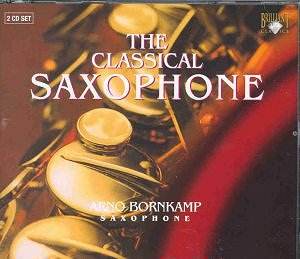Classical
pieces for saxophone have done well over the last five years with
multiple discs issued on Arte Nova, Naxos and Marco Polo. Champions
such as John Harle have taken centre-stage and works like Where
the Bee Sings by Michael Nyman have held court in concert
halls, on television and on radio. The instrument effortlessly
bestrides classical, jazz and popular. It has followers who are
entranced by its strangely mellifluous throatily vocal speaking
tone. The boundaries between classical and popular tend to fade
in the face of such loyalty.
What
do we have here. Two discs: one with music for sax and orchestra;
the other for sax and piano. The orchestral material is especially
fascinating.
The
single movement Glazunov is a central monument to the concertante
literature for the instrument. It is an epitome of the lyrical
tradition. Although written in 1936 for Sigurd Rascher it could
easily have been written in 1905 such is its roundedly mellifluous
character. Here it is warmly recorded and cosseted by Bornkamp
and Brilliant. It is a lovely work and should be in your collection.
If you know the Violin Concerto then you have some idea what to
expect. The two Koechlin sonatinas (primarily written for
oboe d'amore but here disporting in the composer's alternative
version for saxophone) are more in the nature of suites. They
are sometimes classically poised rather than romantically eloquent
although the third movement of the second sonatina is more dreamily
complex. Think of them as similar in effect to the Albinoni or
Pergolesi concertos as arranged by Arthur Benjamin. The gem of
the two suites is the first movement of the second sonatina.
I
was much looking forward to the Caplet having heard his
scorchingly imaginative and tragic Epiphanie for cello
and orchestra earlier this year. This dates from much earlier
in the composer's short life at a time when the saxophone had
its first solo celebrity. It is a rhapsodically extended piece
with a pleasing serenading character but without the scorch and
acid of Epiphanie. The work was uncovered as recently as
1988 by Londeix. The Ibert is truculently flighty and extremely
showy with a pronounced jazzy 'Tin Pan Alley' attitude in the
Allegro con moto and concluding Animato molto giving
way to a melancholic siesta in the Larghetto.
The
second CD has eighteen pieces for saxophone and Ivo Janssen's
piano. The Demersseman has the cantabile of Bellini and
the bubbling effervescence of the Weber and Crusell concertos
for clarinet. The Bizet Intermezzo starts sternly
with beetling Beethovenian clangour from the piano. The Mussorgsky
will be familiar from the orchestral version. The sultry Ravel
piece may be less familiar. Françaix's suite, across
its five miniature movements, is alive with Latin American atmosphere,
is scatty and athletically rhythmic (Pambiche, Mambo,
Merengue) as well as dreamily sultry (Baiao, Samba
lenta). The slow treading Bozza Aria is Bach-like
(perhaps influenced by Villa-Lobos) in its sustained cantabile.
The Jolivet is at first an exotic siesta of a piece then
takes off in unmistakably Gershwin-like directions. The Wiedoft
piece is a hesitation waltz reeking of the Palm Court with a central
tumble-chase. Here Bornkamp rather guys the sentimentality. Shaposhnikova's
arrangements of the three Gershwin preludes for solo piano
lend all three pieces a disconcertingly updated feeling through
their treatments and effects. This is not a purist approach but
it is good to hear the traces kicked over in this way. The famous
Vocalise is treated to a peaceable contemplative rather
sleepy approach. At 7.13 it is the longest piece on CD2. Bornkamp
should have a look at Medtner's Sonata-Vocalise or indeed
John Foulds' Lyra Celtica as pieces probably also suitable
for such arrangements. The Itturalde is from 1983 and is
not quite the sort of commercial pandering I had feared. It is
succulently melodic and elusively melancholic until we get to
the wild czardas. From five years later comes Matitia's
gatling speed piece - chattering jerky superficialities - ragtime
and Dixey!
Bornkamp
was born in Amsterdam in 1959. He has developed a reputation as
a lyrical soloist who is happy with high tide romantic works for
the instrument as well as the contemporary works of Franco Donatoni,
Louis Andriessen and Geert van Keulen. His solo debut took place
in Rome in 1982 with the Ibert concerto. He has studied with Jean-Marie
Londeix and worked with the composers Luciano Berio and Karlheinz
Stockhausen. His tone is extremely warm. His key movements are
silent - no finger-clatter.
Defying
Brilliant's occasional practice the notes and discographical details
are on this occasion detailed and exemplary.
The
singing soul of the instrument is laid bare against the background
of the orchestra in the first disc and the piano in the second.
Only the ultra-contemporary side has been neglected. The commercial
jollity of Itturalde and Matitia don't fit that bill. Superbargain
basement price. Even seasoned collectors will find much here to
reward their negligible outlay.
Rob
Barnett


